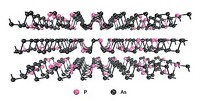Advertisement
Grab your lab coat. Let's get started
Welcome!
Welcome!
Create an account below to get 6 C&EN articles per month, receive newsletters and more - all free.
It seems this is your first time logging in online. Please enter the following information to continue.
As an ACS member you automatically get access to this site. All we need is few more details to create your reading experience.
Not you? Sign in with a different account.
Not you? Sign in with a different account.
ERROR 1
ERROR 1
ERROR 2
ERROR 2
ERROR 2
ERROR 2
ERROR 2
Password and Confirm password must match.
If you have an ACS member number, please enter it here so we can link this account to your membership. (optional)
ERROR 2
ACS values your privacy. By submitting your information, you are gaining access to C&EN and subscribing to our weekly newsletter. We use the information you provide to make your reading experience better, and we will never sell your data to third party members.
Materials
Chemical treatment protects and improves promising 2-D material
Functionalizing black phosphorus with diazonium compounds can block oxidation
by Mitch Jacoby
May 5, 2016
| A version of this story appeared in
Volume 94, Issue 19

Ultrathin flakes of black phosphorus boast a collection of impressive physical properties that make the material a sought-after semiconductor for fast, flexible electronics. But black phosphorus degrades quickly in air, which alters those properties and puts the kibosh on prospects for using it in applications.
A newly developed chemical treatment may be just what black phosphorus needs to improve its chances of being used as a high-performance, two-dimensional electronic material.
A team of Northwestern University researchers led by materials science and chemistry professor Mark C. Hersam reports that treating flakes of black phosphorus with a solution of a benzenediazonium derivative passivates and protects the material and improves its electronic properties (Nat. Chem. 2016, DOI: 10.1038/nchem.2505).
Black phosphorus is the most thermodynamically stable allotrope of phosphorus. Compared with many other 2-D materials, black phosphorus has a combination of properties that make it potentially useful in optoelectronics, energy storage, and molecular sensing applications. These properties include high charge-carrier mobility and a tunable band gap, which can be used to customize the material’s electronic attributes for applications.
But when prepared as nanometer-thick films, black phosphorus degrades in the presence of water and oxygen. That sensitivity has led researchers to develop methods for protecting the material.
To evaluate the new chemical procedure, the Northwestern team prepared flakes of black phosphorus about 10 nm thick by peeling away layers from a small chunk of the material. They treated the samples with solutions of various concentrations of the tetrafluoroborate salts of 4-nitrobenzenediazonium and 4-methoxybenzenediazonium.
The researchers found that untreated samples react with ambient water and oxygen, forming phosphorus oxide. Oxidation lowers the samples’ conductivity and roughens their surfaces, as observed via atomic force microscopy (AFM).
In contrast, treated samples resist degradation. On the basis of spectroscopy analyses, the group reports that the diazonium compounds functionalize the flakes, forming covalent P–C bonds. Through AFM measurements, the team found that the procedure protects black phosphorus from oxidation for as long as 25 days.
To gauge how the treatment affects black phosphorus’s electronic properties, the team fashioned devices called field-effect transistors (FETs). The flakes served as the FET channel, which is the circuit component through which charge flows between the device’s electrodes. They found that the chemical procedure increases charge mobility and leads to a larger difference between the currents that flow in the “on” and “off” states of the device, a basic requirement for a fast-acting switch.
David Tomanek, a physics professor at Michigan State University, notes that previous work on passivating black phosphorus relied on sandwiching the material between protective layers. The new method is very different and appears useful, he says: It passivates the material and improves its properties.
Yale University’s Fengnian Xia, a pioneer in black phosphorus research, remarks that scientists could tweak the chemical treatment to tailor certain electronic properties as needed. He adds, “This is a very important step toward the application of black phosphorus in nanoelectronics and nanophotonics.”
This article has been translated into Spanish by Divulgame.org and can be found here.




Join the conversation
Contact the reporter
Submit a Letter to the Editor for publication
Engage with us on Twitter